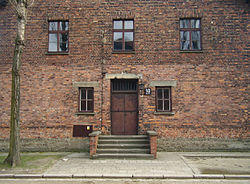This article includes a list of general references, but it lacks sufficient corresponding inline citations .(November 2019) |


Block 10 was a barrack at the Auschwitz concentration camp where men and women were used as experimental subjects for Nazi doctors. The experiments in Block 10 tested bodily reactions to various substances, ranging from no effect to sterilization.
Contents
Although Block 10 was in Auschwitz I, a part of the camp mainly used for male political prisoners, the experiments conducted were mostly on women. The main doctors who worked in Block 10 were Carl Clauberg, Horst Schumann, Eduard Wirths, Bruno Weber and August Hirt. Each of them had different methods in doing experiments on the inmates.
The prisoners at Auschwitz were also deported to other sites where experimental subjects were needed. For example, twenty Jewish children were transported to the Neuengamme concentration camp in Hamburg where they were injected with virulent tubercular serum and subjected to other experiments, and later murdered at the Bullenhuser Damm school. [ citation needed ]